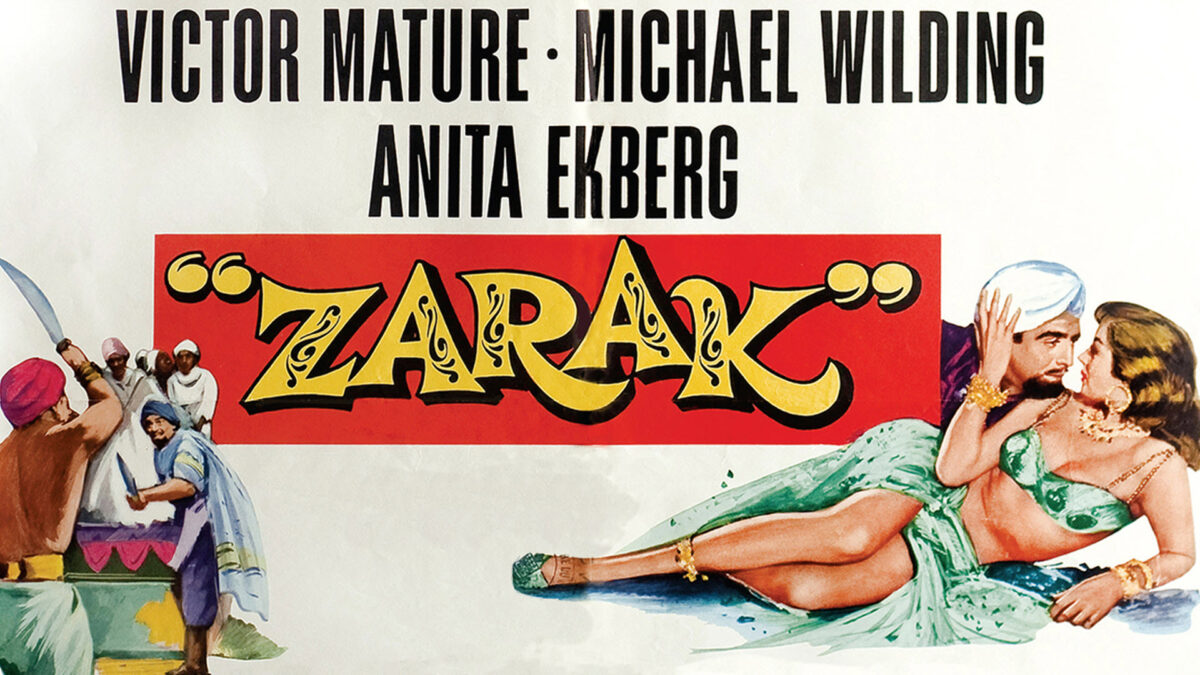Introduction:
In the annals of cinematic history, the year 1956 bestowed upon the world an adventurous gem that transcends the boundaries of time, captivating audiences with its epic storytelling and timeless allure – “Zarak.” Directed by Terence Young, this action-packed adventure film takes viewers on a journey through the rugged landscapes of Northern India, weaving a tale of honor, love, and the indomitable spirit of the human soul. As we delve into the heart of “Zarak,” we uncover the cinematic brilliance that defines this classic piece of cinema, showcasing the artistry and charisma that have earned it a revered place among vintage film enthusiasts.
Plot Summary:
Set against the backdrop of the turbulent Northwest Frontier Province in British India, “Zarak” unfolds with a sweeping narrative that intertwines the fates of its characters. At the center of the story is Zarak Khan (played by Victor Mature), a tribal leader and outlaw known for his defiance against the British authorities. When he is captured and imprisoned, his path intersects with the compassionate nurse Linda (played by Anita Ekberg), sparking a love story that transcends cultural boundaries.
As the plot unravels, “Zarak” becomes a tale of redemption, sacrifice, and the struggle for freedom. Zarak’s journey takes unexpected turns, intertwining with the complex dynamics of colonial rule, tribal loyalties, and the resilience of the human spirit. Against the backdrop of a breathtaking landscape, the characters grapple with their destinies, and viewers are taken on an emotional roller coaster that transcends the boundaries of mere adventure.
Cinematic Brilliance:
- Visual Grandeur: One of the defining features of “Zarak” is its visual grandeur, masterfully captured by cinematographer John Wilcox. The film embraces the vast and rugged landscapes of Northern India, utilizing the majestic scenery to enhance the narrative’s depth and authenticity. The sweeping shots of deserts, mountains, and tribal territories not only serve as a backdrop but also become integral components of the storytelling, immersing the audience in the world of Zarak Khan.
- Charismatic Performances: The success of any classic film hinges on the prowess of its cast, and “Zarak” boasts performances that resonate with authenticity and charisma. Victor Mature, in the titular role, delivers a nuanced portrayal of a complex character torn between rebellion and redemption. Anita Ekberg, as the compassionate nurse Linda, adds a touch of grace and empathy to the narrative. The supporting cast, including Michael Wilding and Bonar Colleano, contributes to the film’s overall brilliance with their compelling performances.
- Cinematic Prowess of Terence Young: Directed by Terence Young, who would later achieve acclaim for his work on the James Bond series, “Zarak” reflects the early signs of his cinematic prowess. Young’s directorial choices, from framing shots against the stunning landscapes to capturing intimate moments of human emotion, showcase a keen understanding of visual storytelling. The pacing of the film, combined with its sweeping score, contributes to an immersive experience that stands the test of time.
- Themes of Honor and Redemption: At its core, “Zarak” delves into universal themes of honor, redemption, and the struggle for justice. The character of Zarak Khan becomes a symbol of defiance against oppression, mirroring the spirit of resistance found in various cultures throughout history. The film explores the complexities of colonial rule, the clash of civilizations, and the indomitable human spirit that rises above adversity.
- Captivating Romance: Amidst the backdrop of political turmoil and tribal conflicts, “Zarak” weaves a captivating romance between Zarak Khan and Linda. The love story serves as a poignant counterpoint to the film’s action sequences, adding layers of emotion and humanity to the narrative. The chemistry between Victor Mature and Anita Ekberg elevates the romance, making it a memorable aspect of the film.
Legacy and Impact:
“Zarak” holds a special place in the hearts of classic film enthusiasts, enduring as a testament to the golden era of adventure cinema. While it may not be as widely celebrated as some of its contemporaries, the film’s legacy lies in its ability to transport audiences to a bygone era, where sweeping landscapes and captivating storytelling reigned supreme.
The impact of “Zarak” extends beyond its initial release, influencing subsequent generations of filmmakers and enthusiasts who appreciate the artistry of classic cinema. The film’s themes of honor, love, and resilience continue to resonate, offering a timeless narrative that transcends the limitations of its era.
Conclusion:
In the realm of adventure and action cinema, “Zarak” (1956) stands as a cinematic triumph, a timeless journey into the heart of honor, love, and rebellion. As we revisit the rugged landscapes of Northern India through the lens of Terence Young, we are reminded of the enduring allure of classic filmmaking. The charismatic performances, visual grandeur, and thematic richness of “Zarak” solidify its place among the cherished classics of yesteryears, beckoning cinephiles to immerse themselves in the epic tale of Zarak Khan and the indomitable spirit that defines his legacy.
